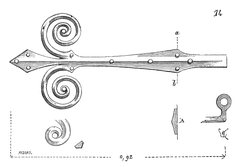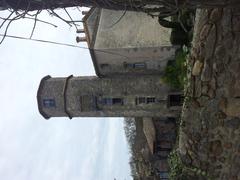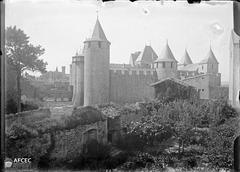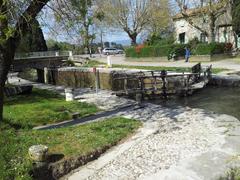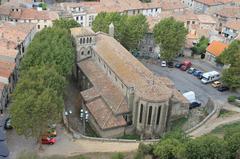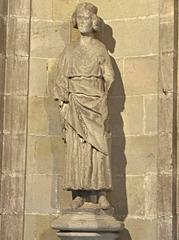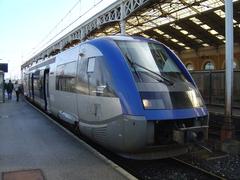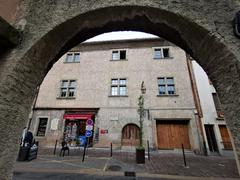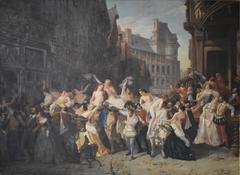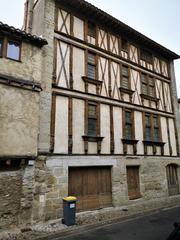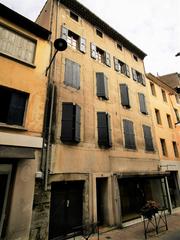Portail des Jacobins Visiting Hours, Tickets, and Travel Guide for Carcassonne Historical Sites
Date: 14/06/2025
Introduction
Discover the Portail des Jacobins, the last surviving gate of Carcassonne’s original Bastide Saint-Louis fortifications, and a landmark that bridges the city’s medieval foundations with its neoclassical transformation. This comprehensive guide offers a detailed historical overview, practical visitor information—including hours and ticketing—architectural insights, and travel tips to help you make the most of your visit to this emblematic Carcassonne site (carcassonne.org, navaway.fr, tourisme-carcassonne.fr).
Table of Contents
- Introduction
- Historical Background
- Architectural Features and Symbolism
- Role in Carcassonne’s Urban and Social History
- Visiting Information
- Preservation and Contemporary Significance
- Frequently Asked Questions (FAQ)
- Conclusion and Visitor Tips
- References
Historical Background
Medieval Origins and Urban Context
The Portail des Jacobins, constructed between 1355 and 1359, was part of Carcassonne’s effort to rebuild and fortify the lower town (Bastide Saint-Louis) after destruction during the Hundred Years’ War. The original bastide featured robust ramparts and four monumental gates—of which only the Portail des Jacobins remains today (carcassonne.org). Its name derives from the nearby Jacobins convent, a Dominican establishment central to Carcassonne’s religious and civic fabric.
Strategically positioned to control northern access, the gate regulated trade and movement, serving both defensive and administrative purposes.
18th-Century Reconstruction
By the late 18th century, urban development and changing architectural tastes led to the reconstruction of the gate in neoclassical style. In 1778, the city’s council authorized redevelopment, and the project was completed in 1779 by architect M. Dalbeau. This transformation marked the transition from medieval defense to civic monument, blending utility with Enlightenment ideals of symmetry and proportion (carcassonne.org).
Architectural Features and Symbolism
The Portail des Jacobins is characterized by its robust limestone construction, semi-circular Romanesque arch, and restrained neoclassical decoration. The façade features a prominent keystone and pilasters, emphasizing symmetry. Once, it bore impressive escutcheons: the external shield displayed the royal arms encircled by the Orders of Saint Louis and Saint Michael, while the internal shield bore the city’s arms and a comital crown (Gralon). Adjacent to the gate is a rare 18th-century fountain with a semi-domed (cul de four) design, integrating civic amenities into defensive architecture.
This blend of military and civic symbolism reflects Carcassonne’s evolving identity and its enduring role as a regional center.
Role in Carcassonne’s Urban and Social History
Serving as the main northern gateway, the Portail des Jacobins was crucial for travelers and merchants arriving from Toulouse and the Languedoc region (Monumentum). Its location at the junction of major boulevards made it a focal point of activity, commerce, and ceremonial events. Over time, the surrounding area evolved, with adjacent buildings and urbanization reflecting the changing needs and fortunes of the city (Musique et Patrimoine de Carcassonne).
Despite changes and partial obscuration due to urban development, the gate remains a powerful symbol of Carcassonne’s civic identity and resilience.
Visiting Information
Opening Hours and Tickets
- Hours: The Portail des Jacobins is an open-air monument accessible 24/7. It is recommended to visit during daylight hours for optimal viewing and photography.
- Tickets: Entry is free. No ticket or reservation is required to visit the gate itself. Guided tours or combined site visits (e.g., the Cité de Carcassonne) may require separate tickets (navaway.fr).
Accessibility
The gate stands on level ground in Place du Général de Gaulle/Rue Courtejaire and is accessible for wheelchair users and visitors with mobility challenges. Paved walkways and nearby public amenities increase accessibility, though some uneven surfaces may be encountered due to the area’s historic character.
Travel Tips and Nearby Attractions
-
Getting There: A 15-minute walk from Carcassonne train station through the Bastide Saint-Louis. Public transport and nearby parking are available.
-
Nearby Sites:
- Cité de Carcassonne (UNESCO World Heritage Site)
- Basilica of Saints Nazarius and Celsus
- Musée des Beaux-Arts de Carcassonne
- Place Carnot—the main square with cafes and market
- Pont Vieux—medieval bridge leading to the citadel
- Brasserie à 4 Temps—Michelin Bib Gourmand restaurant
-
Suggested Route: Start at the train station, walk through Bastide Saint-Louis, pass through the Portail des Jacobins, and continue to Pont Vieux and the medieval citadel.
Guided Tours and Events
The Portail des Jacobins is included in many walking tours of Carcassonne (offered by local tourism offices and agencies), which provide historical context and anecdotes. Special events and festivals, particularly during the summer or European Heritage Days, often feature the gate as a highlight.
Photography
For the best photos, visit early in the morning or late afternoon when sunlight enhances the limestone’s textures and the gate’s neoclassical lines. The open plaza and adjacent park offer varied perspectives.
Preservation and Contemporary Significance
Continuous restoration and preservation efforts have maintained the Portail des Jacobins as a vital element of Carcassonne’s architectural heritage (gpsmycity.com). The gate’s survival, when other entrances were lost, underscores its importance as a tangible link between Carcassonne’s medieval origins and modern urban life.
Frequently Asked Questions (FAQ)
Q: What are the opening hours of the Portail des Jacobins?
A: The gate is open 24/7 as a public monument; best visited during daylight hours.
Q: Is there an entry fee or ticket required?
A: No, it is free to visit. Guided tours of the area may require separate tickets.
Q: Is the site accessible for people with disabilities?
A: Yes, the area is generally accessible with paved walkways.
Q: Are guided tours available?
A: Yes, the gate is included in many walking tours of Carcassonne.
Q: How do I get there from the train station?
A: A 15-minute flat walk through Bastide Saint-Louis.
Q: Are there notable restaurants or amenities nearby?
A: Yes, including Brasserie à 4 Temps and several cafes and shops in Place Carnot.
Conclusion and Visitor Tips
The Portail des Jacobins, with its neoclassical elegance and layered history, is a cornerstone of Carcassonne’s urban fabric. As the last of the original Bastide Saint-Louis gates, it stands as a living monument to the city’s resilience and cultural evolution. Its free, open-air accessibility makes it an essential stop for travelers seeking both historical depth and vibrant local life.
For a richer experience, pair your visit with guided tours, explore nearby attractions, and sample regional cuisine. Early mornings and late afternoons offer the best light for photography, while festivals and events provide lively cultural immersion. For interactive audio guides and real-time information, consider downloading the Audiala app, and check official tourism sources for event updates.
References
- Carcassonne Official Tourism
- Navaway Guide to Carcassonne
- Tourisme Carcassonne
- Gralon
- Monumentum
- Musique et Patrimoine de Carcassonne
- JJ Bucketlist Travellers
- GPSMyCity

